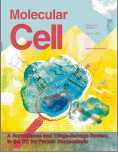Nature:感染艾滋病毒的T细胞是病毒传播的运输载体
2012-08-03 songbo 生物谷
通过粘膜表面进入机体后,人类免疫缺陷病毒1(HIV-1)传播到淋巴组织,造成免疫系统的全身性感染。这种病毒早期传播的机制是不清楚的。体外研究表明,在感染和未感染的T细胞之间的稳定联系的病毒突触的形成,大大提高病毒转移的效率。但是目前还不清楚,在细胞持续运动于上皮和淋巴组织的条件下,体内T细胞间的接触是否足够稳定以利于功能性突触的形成。 本研究使用活体多光子显微镜,研究人源化的小鼠淋巴结内,感染艾
通过粘膜表面进入机体后,人类免疫缺陷病毒1(HIV-1)传播到淋巴组织,造成免疫系统的全身性感染。这种病毒早期传播的机制是不清楚的。体外研究表明,在感染和未感染的T细胞之间的稳定联系的病毒突触的形成,大大提高病毒转移的效率。但是目前还不清楚,在细胞持续运动于上皮和淋巴组织的条件下,体内T细胞间的接触是否足够稳定以利于功能性突触的形成。
本研究使用活体多光子显微镜,研究人源化的小鼠淋巴结内,感染艾滋病毒的T细胞的动态行为。结果发现,高度感染病毒的T细胞迁移,导致其在整个淋巴结皮质的均匀分布。
受感染的细胞的一部分,通过HIV包膜依赖性细胞融合,形成多核合胞体。合胞体不协调蠕动,并粘连到CD4+淋巴结细胞,导致形成长形细胞膜系链,致使感染细胞的长度增加到未感染的迁移T细胞的十倍。
阻断T细胞从淋巴结迁徙到传出淋巴管的出口,从而中断T细胞的再循环,可限制艾滋病毒的播散和有效降低血浆病毒血症。
因此,淋巴结中的T细胞的迁移,和这些感染细胞通过组织再循环,是体内播散HIV病毒的关键,这也许会成为对抗艾滋病毒感染的分子靶点。

doi:10.1016/j.cell.2011.10.017
PMC:
PMID:
HIV-infected T cells are migratory vehicles for viral dissemination
Thomas T. Murooka,Maud Deruaz,Francesco Marangoni,Vladimir D. Vrbanac,Edward Seung,Ulrich H. von Andrian,Andrew M. Tager,Andrew D. Luster& Thorsten R. Mempel
After host entry through mucosal surfaces, human immunodeficiency virus-1 (HIV-1) disseminates to lymphoid tissues to establish a generalized infection of the immune system. The mechanisms by which this virus spreads among permissive target cells locally during the early stages of transmission and systemically during subsequent dissemination are not known1. In vitro studies suggest that the formation of virological synapses during stable contacts between infected and uninfected T cells greatly increases the efficiency of viral transfer2. It is unclear, however, whether T-cell contacts are sufficiently stable in vivo to allow for functional synapse formation under the conditions of perpetual cell motility in epithelial3 and lymphoid tissues4. Here, using multiphoton intravital microscopy, we examine the dynamic behaviour of HIV-infected T cells in the lymph nodes of humanized mice. We find that most productively infected T cells migrate robustly, resulting in their even distribution throughout the lymph node cortex. A subset of infected cells formed multinucleated syncytia through HIV envelope-dependent cell fusion. Both uncoordinated motility of syncytia and adhesion to CD4+ lymph node cells led to the formation of long membrane tethers, increasing cell lengths to up to ten times that of migrating uninfected T cells. Blocking the egress of migratory T cells from the lymph nodes into efferent lymph vessels, and thus interrupting T-cell recirculation, limited HIV dissemination and strongly reduced plasma viraemia. Thus, we have found that HIV-infected T cells are motile, form syncytia and establish tethering interactions that may facilitate cell-to-cell transmission through virological synapses. Migration of T cells in lymph nodes therefore spreads infection locally, whereas their recirculation through tissues is important for efficient systemic viral spread, suggesting new molecular targets to antagonize HIV infection.
本网站所有内容来源注明为“梅斯医学”或“MedSci原创”的文字、图片和音视频资料,版权均属于梅斯医学所有。非经授权,任何媒体、网站或个人不得转载,授权转载时须注明来源为“梅斯医学”。其它来源的文章系转载文章,或“梅斯号”自媒体发布的文章,仅系出于传递更多信息之目的,本站仅负责审核内容合规,其内容不代表本站立场,本站不负责内容的准确性和版权。如果存在侵权、或不希望被转载的媒体或个人可与我们联系,我们将立即进行删除处理。
在此留言









#载体#
67
#Nat#
53